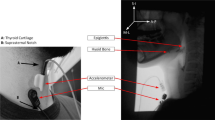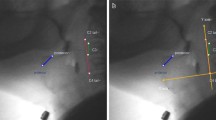Abstract
Identifying physiological impairments of swallowing is essential for determining accurate diagnosis and appropriate treatment for patients with dysphagia. The hyoid bone is an anatomical landmark commonly monitored during analysis of videofluoroscopic swallow studies (VFSSs). Its displacement is predictive of penetration/aspiration and is associated with other swallow kinematic events. However, VFSSs are not always readily available/feasible and expose patients to radiation. High-resolution cervical auscultation (HRCA), which uses acoustic and vibratory signals from a microphone and tri-axial accelerometer, is under investigation as a non-invasive dysphagia screening method and potential adjunct to VFSS when it is unavailable or not feasible. We investigated the ability of HRCA to independently track hyoid bone displacement during swallowing with similar accuracy to VFSS, by analyzing vibratory signals from a tri-axial accelerometer using machine learning techniques. We hypothesized HRCA would track hyoid bone displacement with a high degree of accuracy compared to humans. Trained judges completed frame-by-frame analysis of hyoid bone displacement on 400 swallows from 114 patients and 48 swallows from 16 age-matched healthy adults. Extracted features from vibratory signals were used to train the predictive algorithm to generate a bounding box surrounding the hyoid body on each frame. A metric of relative overlapped percentage (ROP) compared human and machine ratings. The mean ROP for all swallows analyzed was 50.75%, indicating > 50% of the bounding box containing the hyoid bone was accurately predicted in every frame. This provides evidence of the feasibility of accurate, automated hyoid bone displacement tracking using HRCA signals without use of VFSS images.



Similar content being viewed by others
References
Martin-Harris B. The VFS study. Phys Med Rehabil Clin N Am. 2008;19(4):769–85. https://doi.org/10.1016/j.pmr.2008.06.004.The.
Molfenter SM, Steele CM. Physiological variability in the deglutition literature: Hyoid and laryngeal kinematics. Dysphagia. 2011;26(1):67–74. https://doi.org/10.1007/s00455-010-9309-x.
Vandaele DJ, Perlman AL, Cassell MD. Intrinsic fibre architecture and attachments of the human epiglottis and their contributions to the mechanism of deglutition. J Anat. 1995;186:1–15.
Kim Y, McCullough GH. Maximum hyoid displacement in normal swallowing. Dysphagia. 2008;23(3):274–9. https://doi.org/10.1007/s00455-007-9135-y.
Kendall KA, Leonard RJ. Hyoid movement during swallowing in older patients with dysphagia. Arch Otolaryngol-Head Neck Surg. 2001;127(10):1224–9. https://doi.org/10.1001/archotol.127.10.1224.
Matsuo K, Palmer JB. Anatomy and physiology of feeding and swallowing: Normal and abnormal. Phys Med Rehabil Clin N Am. 2008;19(4):691–707. https://doi.org/10.1016/j.pmr.2008.06.001.
Zhang Z, Perera S, Donohue C, et al. The prediction of risk of penetration–aspiration via hyoid bone displacement features. Dysphagia. 2019. https://doi.org/10.1007/s00455-019-10000-5.
Perlman AL, Booth BM, Grayhack JP. Videofluoroscopic predictors of aspiration in patients with oropharyngeal dysphagia. Dysphagia. 1994;9(2):90–5. https://doi.org/10.1007/BF00714593.
Molfenter SM, Steele CM. Kinematic and temporal factors associated with penetration-aspiration in swallowing liquids. Dysphagia. 2014;29(2):269–76. https://doi.org/10.1007/s00455-013-9506-5.
McCullough GH, Kim Y. Effects of the mendelsohn maneuver on extent of hyoid movement and UES opening post-stroke. Dysphagia. 2013;28(4):511–9. https://doi.org/10.1007/s00455-013-9461-1.
Wheeler-Hegland KM, Rosenbek JC, Sapienza CM. Submental sEMG and hyoid movement during mendelsohn maneuver, effortful swallow, and expiratory muscle strength training. J Speech Lang Hear Res. 2008;51(5):1072–87. https://doi.org/10.1044/1092-4388(2008/07-0016).
Martin-Harris B, Brodsky MB, Michel Y, et al. MBS measurement tool for swallow impairment-MBSimp: establishing a standard. Dysphagia. 2008;23(4):392–405. https://doi.org/10.1007/s00455-008-9185-.
Vose AK, Kesneck S, Sunday K, Plowman E, Humbert I. A survey of clinician decision making when identifying swallowing impairments and determining treatment. J Speech Lang Hear Res. 2018;61(11):2735–56. https://doi.org/10.1044/2018_jslhr-s-17-0212.
Suiter DM, Sloggy J, Leder SB. Validation of the yale swallow protocol: a prospective double-blinded videofluoroscopic study. Dysphagia. 2014;29(2):199–203. https://doi.org/10.1007/s00455-013-9488-3.
Groves-Wright KJ, Boyce S, Kelchner L. Perception of wet vocal quality in identifying penetration/aspiration during swallowing. J Speech Lang Hear Res. 2009;53(3):620–32. https://doi.org/10.1044/1092-4388(2009/08-0246).
Waito A, Bailey GL, Molfenter SM, Zoratto DC, Steele CM. Voice-quality abnormalities as a sign of dysphagia: validation against acoustic and videofluoroscopic data. Dysphagia. 2011;26(2):125–34. https://doi.org/10.1007/s00455-010-9282-4.
Ramagalla AR, Sadanandam P, Rajasree TK. Age related metric changes in the hyoid bone. IOSR J Dent Med Sci. 2014;13(7):54–6. https://doi.org/10.9790/0853-13765456.
Loth A, Corny J, Santini L, et al. Analysis of hyoid–larynx complex using 3D geometric morphometrics. Dysphagia. 2015;30(3):357–64. https://doi.org/10.1007/s00455-015-9609-2.
Brates D, Molfenter SM, Thibeault SL. Assessing hyolaryngeal excursion: comparing quantitative methods to palpation at the bedside and visualization during videofluoroscopy. Dysphagia. 2019;34(3):298–307. https://doi.org/10.1007/s00455-018-9927-2.
Sejdic E, Steele CM, Chau T, Member S. Classification of penetration: aspiration versus healthy swallows using dual-axis swallowing accelerometry signals in dysphagic subjects. IEEE Trans Biomed Eng. 2013;60(7):1859–66.
Dudik JM, Coyle JL, Sejdic E. Dysphagia screening : contributions of cervical auscultation signals and modern signal-processing techniques. IEEE Trans Hum-Mach Syst. 2015;45(4):465–77.
Dudik JM, Jestrovic I, Luan B, Coyle JL, Sejdic E. A comparative analysis of swallowing accelerometry and sounds during saliva swallows. Biomed Eng Online. 2015;3:1–15.
Dudik JM, Kurosu A, Coyle JL, Sejdic E. A comparative analysis of DBSCAN K-means, and quadratic variation algorithms for automatic identification of swallows from swallowing accelerometry signals. Comput Biol Med. 2015;59:10–8. https://doi.org/10.1016/j.compbiomed.2015.01.007.
Jestrovic I, Dudik JM, Luan B, Coyle JL, Sejdic E. Baseline characteristics of cervical auscultation signals during various head maneuvers. Comput Biol Med. 2013;2014(43):2014–20. https://doi.org/10.1016/j.compbiomed.2013.10.005.
Movahedi F, Kurosu A, Coyle JL, Perera S, Sejdic E. Computer methods and programs in biomedicine: a comparison between swallowing sounds and vibrations in patients with dysphagia. Comput Methods Progr Biomed. 2017;144:179–87. https://doi.org/10.1016/j.cmpb.2017.03.009.
Dudik JM, Coyle JL, El-Jaroudi A, Mao ZH, Sun M, Sejdić E. Deep learning for classification of normal swallows in adults. Neurocomputing. 2018;285:1–9. https://doi.org/10.1016/j.neucom.2017.12.059.
Kurosu A, Coyle JL, Dudik JM, Sejdic E. Detection of swallow kinematic events from acoustic high-resolution cervical auscultation signals in patients with stroke. Arch Phys Med Rehabil. 2019;100(3):501–8. https://doi.org/10.1016/j.apmr.2018.05.038.
Rebrion C, Zhang Z, Khalifa Y, et al. High-resolution cervical auscultation signal features reflect vertical and horizontal displacements of the hyoid bone during swallowing. IEEE J Transl Eng Heal Med. 2019. https://doi.org/10.1109/JTEHM.2018.2881468.
Zhang Z, Coyle JL, Sejdić E. Automatic hyoid bone detection in fluoroscopic images using deep learning. Sci Rep. 2018;8(1):1–9. https://doi.org/10.1038/s41598-018-30182-6.
He Q, Perera S, Khalifa Y, Zhang Z, Mahoney A, Sabry A, Donohue C, Coyle J, Sejdic E. The association of high-resolution cervical auscultation signal features with hyoid bone displacement during swallowing. Trans. Neural Syst Rehabil Eng. 2019. https://doi.org/10.1109/TNSRE.2019.2935302.
Mao S, Zhenwei Z, Khalifa Y, Donohue C, Coyle J, Sejdic E. Neck sensor-supported hyoid bone movement tracking during swallowing. R Soc. 2019. https://doi.org/10.1098/rsos.181982.
Oppenheim AV, Schafer RW. Discrete-Time Signal Processing. Harlow: Pearson; 2014.
Lof GL, Robbins JA. Test-retest variability in normal swallowing. Dysphagia. 1990;4(4):236–42. https://doi.org/10.1007/BF02407271.
Shrout PE, Fleiss JL. Intraclass correlations: uses in assessing rater reliability. Psychol Bull. 2005;86(2):1–9.
Sabry A, Shitong M, Mahoney A, Khalifa Y, Sejdic E, Coyle J. Automatic estimation of laryngeal vestibular closure duration using high resolution cervical auscultation signals. Presentation at the American Speech-Language Hearing Association Convention, Orlando, FL; 2019.
Donohue C, Khalifa Y, Sejdic E, Coyle J. How closely do machine ratings of duration of UES opening during videofluoroscopy approximate clinician ratings using kinematic analysis and the MBSImP? Presentation at the Dysphagia Research Society Annual Meeting, San Diego, CA; 2019
Acknowledgements
People: Thanks are due to Amanda Mahoney, MA SLP, Aliaa Sabry, MD/PhD, Atsuko Kurosu, PhD, and Zhenwei Zhang, MS, for assistance with data collection and coding.
Funding
Research reported in this publication was supported by the Eunice Kennedy Shriver National Institute of Child Health & Human Development of the National Institutes of Health under Award Number R01HD092239, while the data were collected under Award Number R01HD074819. The content is solely the responsibility of the authors and does not necessarily represent the official views of the National Institutes of Health or National Science Foundation.
Author information
Authors and Affiliations
Corresponding author
Additional information
Publisher's Note
Springer Nature remains neutral with regard to jurisdictional claims in published maps and institutional affiliations.
Rights and permissions
About this article
Cite this article
Donohue, C., Mao, S., Sejdić, E. et al. Tracking Hyoid Bone Displacement During Swallowing Without Videofluoroscopy Using Machine Learning of Vibratory Signals. Dysphagia 36, 259–269 (2021). https://doi.org/10.1007/s00455-020-10124-z
Received:
Accepted:
Published:
Issue Date:
DOI: https://doi.org/10.1007/s00455-020-10124-z




